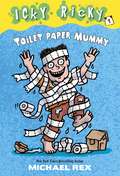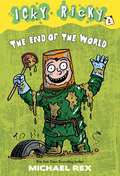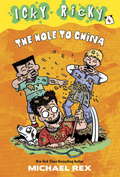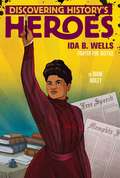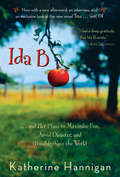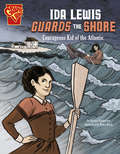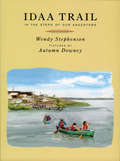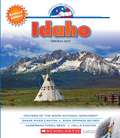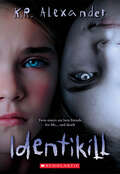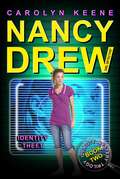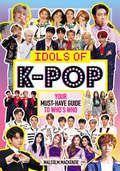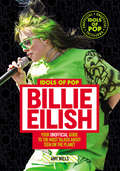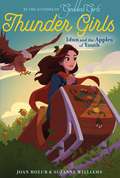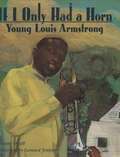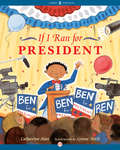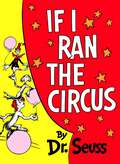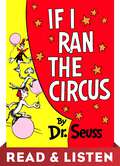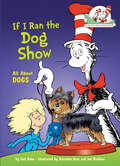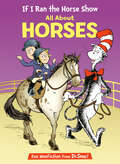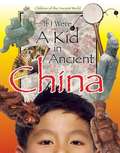- Table View
- List View
Icky Ricky #1: Toilet Paper Mummy (Icky Ricky #1)
by Michael RexThe creator of Goodnight Goon and The Runaway Mummy pulls from his mad-scientist brain a kid so attracted to slime, muck, dirt, and yuck he could only be called Icky Ricky.Uh-oh! Icky Ricky is in trouble and has a lot of explaining to do. Why? Well, you see . . .He did his homework on cheese slices, but got hungry and ate them.He had his friends over for a sleepover . . . on the bedroom ceiling.Senor Pinata Dude, Icky Ricky's hot dog with a mustache, just landed in his dad's toolbox.The town bully, Mean Dean, is looking to pound whoever lost his remote-controlled car. Was is Icky Ricky?Icky Ricky is up to his eyebrows in mayhem--and in ick!
Icky Ricky #2: The End of the World (Icky Ricky #2)
by Michael RexThe creator of Goodnight Goon and The Runaway Mummy pulls from his mad-scientist brain a kid so attracted to slime, muck, dirt, and yuck he could only be called Icky Ricky.Uh-oh! Icky Ricky is in trouble and has a lot of explaining to do. Why? Well, you see . . .Someone spotted Bigfoot in Icky Ricky's neighborhood!Icky Ricky and his friends had a teary funeral . . . for a pepperoni pizza.A crazy one-eyed squirrel stole Icky Ricky's Palooka Pops.Icky Ricky's trashbag hazmat suit might not be enough to protect him from mutants while he's cleaning up trash around town. Is it the end of the world for Icky Ricky?Icky Ricky is up to his eyebrows in mayhem--and in ick!
Icky Ricky #4: The Hole to China
by Michael RexThis Captain Underpants-style Stepping Stones series is half text, half illustration, and 100 percent humor. The creator of Goodnight Goon and The Runaway Mummy pulls from his mad-scientist brain a kid so attracted to slime, muck, dirt, and yuck he could only be called Icky Ricky. And uh-oh! Icky Ricky is in a mess. Why? Well, you see . . . He's digging a hole to China, in his backyard. He found a free toilet in someone's garbage. (Score!) He fell into a pigpen . . . with a muddy mega-pig. Icky Ricky is up to his eyeballs in trouble--and ick!
Icky Squishy Science
by Sandra MarkleFOAM AT THE MOUTH ABOUT SCIENCE! Have you ever wondered why your breath smells bad or how far you can spit? Have you ever wanted to blow up marshmallows or catapult them across a room? Are you inquisitive enough to pet a worm but too queasy to eat one? You may be surprised what this book will get you to do in the name of science. Each experiment is clearly outlined and explained so that you'll not only know how to do something neat like shoot water without a squirt gun, but you'll know why it happens, too. So clear off your kitchen counter, gather a few sample materials, and get ready to roll up your sleeves, pinch your nose, and plunge into some of the slimiest science experiments around!
Ida B. Wells: Discovering History's Heroes (Jeter Publishing)
by Diane BaileyJeter Publishing presents a brand-new series that celebrates men and women who altered the course of history but may not be as well-known as their counterparts. Ida B. Wells was an African-American journalist and activist who led an anti-lynching crusade in the United States in the 1890s. On one fateful train ride from Memphis to Nashville, in May 1884, Wells reached a personal turning point. Having bought a first-class train ticket, she was outraged when the train crew ordered her to move to the car for African Americans. She refused and was forcibly removed from the train—but not before she bit one of the men on the hand. Wells sued the railroad, winning a $500 settlement. However, the decision was later overturned by the Tennessee Supreme Court. This injustice led Ida B. Wells to pick up a pen to write about issues of race and politics in the South. Using the moniker “Iola,” a number of her articles were published in black newspapers and periodicals. Wells eventually became an owner of the Memphis Free Speech and Headlight, and, later, of the Free Speech. She even took on the subject of lynching, and in 1898, Wells brought her anti-lynching campaign to the White House, leading a protest in Washington, DC, and calling for President William McKinley to make reforms. Ida B. Wells never backed down in the fight for justice.
Ida B: and Her Plans to Maximize Fun, Avoid Disaster, and (Possibly) Save the World
by Katherine HanniganIda B. Applewood believes there is never enough time for fun.<P><P> That's why she's so happy to be homeschooled and to spend every free second outside with the trees and the brook. <P> Then some not-so-great things happen in her world. Ida B has to go back to that Place of Slow but Sure Body-Cramping, Mind-Numbing, Fun-Killing Torture-school. She feels her heart getting smaller and smaller and hardening into a sharp, black stone. <P> How can things go from righter than right to a million miles beyond wrong? Can Ida B put together a plan to get things back to just-about perfect again?
Ida Early Comes over the Mountain
by Robert BurchIda Early is as tall as the tales she tells, a gangly scarecrow who comes to the rural Georgia home of widower Mr. Sutton during the Depression years. Her offer to help out for a spell delights the four Sutton children and their father ... and life becomes a three-ring circus for the kids.
Ida Lewis Guards the Shore: Courageous Kid of the Atlantic (Courageous Kids)
by Jessica GundersonIda Lewis spent a lifetime on the water, starting when her family moved the island of Lime Rock in 1857 for her father's job as lighthouse keeper. By age 15, Ida was the best swimmer in Newport, Rhode Island. And when her father suffers a stroke, Ida herself takes over as keeper of the lighthouse. But guarding the shore also means guarding the water. And when Ida spots four local boys in danger on the water, she knows she must take action, the boys' lives depend on it.
Idaa Trail: In The Steps Of Our Ancestors
by Wendy StephensonEtseh, Etsi and their three grandchildren have just embarked on a month long canoe trip in the Northwest Territories -- from the town of Rae to Hottah Lake. They are following the Idaa trail, a trade route that the Dogrib people have traveled for hundreds of years. Etseh and Etsi traveled the Idaa trail when they were children and as they paddle north with their grandchildren they pass along their knowledge of special sites along the way and explain how their people survived in the old days -- building birch bark canoes, fishing with willow lines and muskrat-tooth hooks, and ambushing herds of caribou. This remarkable work, based on ten years of archaeological research, documents the past and present of one of the most intact tribal cultures of North America.
Idaho (America the Beautiful. Third Series)
by Deborah KentSurveys the history, geography, and economy of the Gem State, as well as the diverse ways of life of its people. Lexile Measure: 1050L
Ideas and Inventions: FOSS Science Stories
by University of California at Berkeley Lawrence Hall of ScienceNIMAC-sourced textbook
Ideas brillantes sobre la luz (¡Arriba la Lectura!, Level R #60)
by Kevin AdkinsNIMAC-sourced textbook. La luz es un fenómeno sorprendente que necesitamos para vivir. Lee el libro para conocer detalles interesantes sobre la luz.
Identikill
by K. R. AlexanderOne twin died. One twin lived. But did the dead twin ever let go?From K. R. Alexander, a bestselling master of such middle-grade frights as The Collector and The Fear Zone, comes the story of a girl whose life is inextricably linked to that of her dead twin... who refuses to go away, and wants to take control.
Identity Theft: Book Two in the Identity Mystery Trilogy
by Carolyn KeeneWith George and Bess's help, I joined the online group BetterLife to unmask the identities of some nasty cyberbullies who were harassing a friend of Bess's sister online. Little did I know that my sleuthing would lead me into even more trouble! Now the cyberbullies are after me. Someone has hacked into my BetterLife account and manipulated my avatar to do things I would never do in real life. Now this case is personal. My friends and I need to do some major cybersleuthing to identify the bullies before it's too late!
Idols of K-Pop: Your Must-Have Guide to Who's Who
by Malcolm MackenzieWhether you’re new to K-Pop or a die-hard super stan, Idols of K-Pop is your essential guide to the current K-Pop scene. This unofficial guide features the biggest names in the Korean music genre, including BTS, Blackpink, Twice, Exo, and many more.This guide contains 64 full-color pages all about the world of K-Pop, with up-close photos of the idols, facts, personal info and gossip, candid commentary, and so much more!
Idols of Pop: Your Unofficial Guide to the Most Talked About Teen on the Planet (Idols of Pop)
by Amy WillsBook three in the Idols of Pop series, Idols of Pop: Billie Eilish, is an essential fan-focused guide to the latest and greatest icon in pop music: Billie Eilish!This 64-page book features full-color candid and professional photos with the singer front and center. Packed with personal takes on life, love, music and more, Idols of Pop: Billie Eilish is your guide to one of the hottest pop stars in the world right now
Idriss and His Marble
by René GouichouxWhen war threatens their home, Idriss and his mother must flee. He clutches his lucky charm―a single marble―throughout their journey, walking over hazardous terrain, crawling under barbed wire, and sailing on a fragile little boat. Will the marble's luck help them avoid capture and bring them to the safety of a new world? A heartfelt tale exploring the perilous path refugees often walk to find a new home and the hope it takes to get them there.
Idun and the Apples of Youth: Freya And The Magic Jewel; Sif And The Dwarfs' Treasures; Idun And The Apples Of Youth; Skade And The Enchanted Snow (Thunder Girls #3)
by Joan Holub Suzanne WilliamsFrom the authors of the Goddess Girls series comes the third book in a series steeped in Norse mythology, magic, adventure, and friendship.Twelve-year-old Idun is the goddess of youth, and her magical and deliciously sweet golden apples are what keep all of the academy’s gods and goddesses healthy and youthful. They grow year-round—even in winter snow—in one very special grove in Asgard. But when the mischievous Loki ends up making a bet that jeopardizes Idun—and her powerful apples—she must figure out a way to protect herself and her magical orchards from a giant who wants those apples all to himself! Can Idun save the apples—and the gods and goddesses who rely on them—from the two bad seeds at Asgard Academy?
If I Only Had A Horn: Young Louis Armstrong
by Roxane OrgillFrom the book: There was a poor boy in New Orleans who was in love with music. And music was everywhere in his city -- dancing out of doorways, singing on street corners, best of all there was the great Joe Oliver's cornet crying wah-wah for all to hear. If I only had a horn, that boy thought, I too could sing, bring home pennies, and most of all tap happy feet blues till the sun rose. It wasn't going to be easy. Many things, not all of them good, had to happen before that boy got his horn. But when at last he did, his cornet would send music spiraling up into the New Orleans night sky like a spinning top gone crazy.
If I Ran for President
by Catherine Stier Lynne AvrilImagine starring in commercials and traveling in your own campaign bus! Or seeing your face on bumper stickers and T-shirts! <P><P>If you ran for president, you would get to do these and other fun things, but you would also have to do a lot of hard work. You would study the nation's problems, tell the American people about your platform, select a running mate, and debate your opponents on live television. <P><P>Finally, in November, Election Day would arrive. You would keep your fingers crossed and wait for the results--will you be the next president of the United States? <P><P>A multicultural cast of children imagines what it would be like to run for president. The entertaining yet informative text is a good conversation starter for discussions on the election process. A note about this process accompanies the story. <P><P>The author, Catherine Stier, is no stranger to politics--her previous book, If I Were President, looked at the various responsibilities of the president. Lynne Avril's cheerful illustrations perfectly complement the lively text.
If I Ran the Circus (Classic Seuss)
by Dr. SeussDr. Seuss's classic celebration of youthful imagination! The Circus McGurkus! The World's Greatest Show On the face of the earth, or wherever you go! Young Morris McGurk's has a BIG imagination. He wants to turn the vacant lot behind Sneelock's Store into the Circus McGurkus—the most colossal, stupendous, tremendous show in the world! Here you'll be entertained by bizarre creatures like the Drum-Tummied Snum, the Juggling Jott, and the Harp-Twanging Snarp, and fantastic circus acts performed by Sneelock—a sleepy shop keeper whom Morris images as the daredevil star of his big top! This is Dr. Seuss at his best, celebrating youthful imagination and creating a fantasy world that will delight and transport readers of all ages.
If I Ran the Circus: Read & Listen Edition (Classic Seuss)
by Dr. SeussStep right up for Dr. Seuss&’s classic rhyming picture-book tale of young Morris McGurk&’s big circus dreams. This circus has more than a mere lion tamer and trapeze artist! At the Circus McGurkus, you&’ll be intrigued by the wink-hooded Hoodwink, terrified by the Spotted Atrocious, and amazed by the daring feats of the great Sneelock. And these are just a few of the astonishing things you&’ll find under this big top. Told with the humor and originality that are synonymous with Dr. Seuss, If I Ran the Circus is a crowd-pleasing showstopper!This Read & Listen edition contains audio narration.
If I Ran the Dog Show: All About Dogs (The Cat in the Hat's Learning Library)
by Tish RabeLaugh and learn with fun facts about humankind&’s best friend—dogs!—all told in Dr. Seuss&’s beloved rhyming style and starring The Cat in the Hat. &“I&’m the Cat in the Hat, and today we will go to the Short-Shaggy-Tail-Waggy Super Dog Show!&” The Cat in the Hat&’s Learning Library series combines beloved characters, engaging rhymes, and Seussian illustrations to introduce children to non-fiction topics from the real world! In this doggone fun book, readers will learn about: • the wide variety of dog breeds• their amazing bodies and senses• the growth stages of puppies• and much more! Perfect for story time and for the youngest readers, If I Ran the Dog Show also includes an index, glossary, and suggestions for further learning. Look for more books in the Cat in the Hat&’s Learning Library series!Cows Can Moo! Can You? All About FarmsHark! A Shark! All About SharksOh Say Can You Say Di-no-saur? All About DinosaursOn Beyond Bugs! All About InsectsOne Vote Two Votes I Vote You VoteThere&’s No Place Like Space: All About Our Solar SystemWho Hatches the Egg? All About EggsWhy Oh Why Are Deserts Dry? All About DesertsWish for a Fish: All About Sea Creatures
If I Ran the Horse Show: All About Horses (The Cat in the Hat's Learning Library)
by Bonnie WorthLaugh and learn with fun facts about horses including mustangs, Appaloosas, Icelandic ponies, and more—all told in Dr. Seuss&’s beloved rhyming style and starring the Cat in the Hat! &“The judges are waiting. It&’s time for the show. So pick up the reins . . . giddyup and let&’s go!&” The Cat in the Hat&’s Learning Library series combines beloved characters, engaging rhymes, and Seussian illustrations to introduce children to nonfiction topics from the real world! Take a trip to the Super-Tremendous Stupendous Horse Show and learn: • how horses are measured by hands• what different horses are used for around the world• how horse shoes are made• and much more! Perfect for story time and for the youngest readers, If I Ran the Horse Show: All About Horses also includes an index, glossary, and suggestions for further learning. Look for more books in the Cat in the Hat&’s Learning Library series!Clam-I-Am! All About the BeachMiles and Miles of Reptiles: All About ReptilesA Whale of a Tale! All About Porpoises, Dolphins, and WhalesSafari, So Good! All About African WildlifeThere's a Map on My Lap! All About MapsOh, the Lavas That Flow! All About VolcanoesOut of Sight Till Tonight! All About Nocturnal AnimalsWhat Cat Is That? All About CatsOnce upon a Mastodon: All About Prehistoric MammalsOh Say Can You Say What's the Weather Today? All About WeatherThe Cat on the Mat: All About Mindfulness
If I Were a Kid in Ancient China
by The editors at the Cricket BooksWhat modern boy or girl wouldn’t want to be called “Precious Child,” as parents in ancient China referred to their children? Or wear a beautiful silk brocade jacket, as wealthy youngsters did? Or nibble on a crunchy roasted cricket? This fun book explores every aspect of life for Chinese children “way back when,” from distinctive toys like a live “pet” dragonfly to hand-made lesson books to shopping at the exciting markets or strolling down the Silk Road in search of treasures. Detailed historical background and a glossary bring this intriguing time to life for young readers.
